engine RENAULT FLUENCE Z.E. 2012 Owners Manual
[x] Cancel search | Manufacturer: RENAULT, Model Year: 2012, Model line: FLUENCE Z.E., Model: RENAULT FLUENCE Z.E. 2012Pages: 195, PDF Size: 5.23 MB
Page 11 of 195
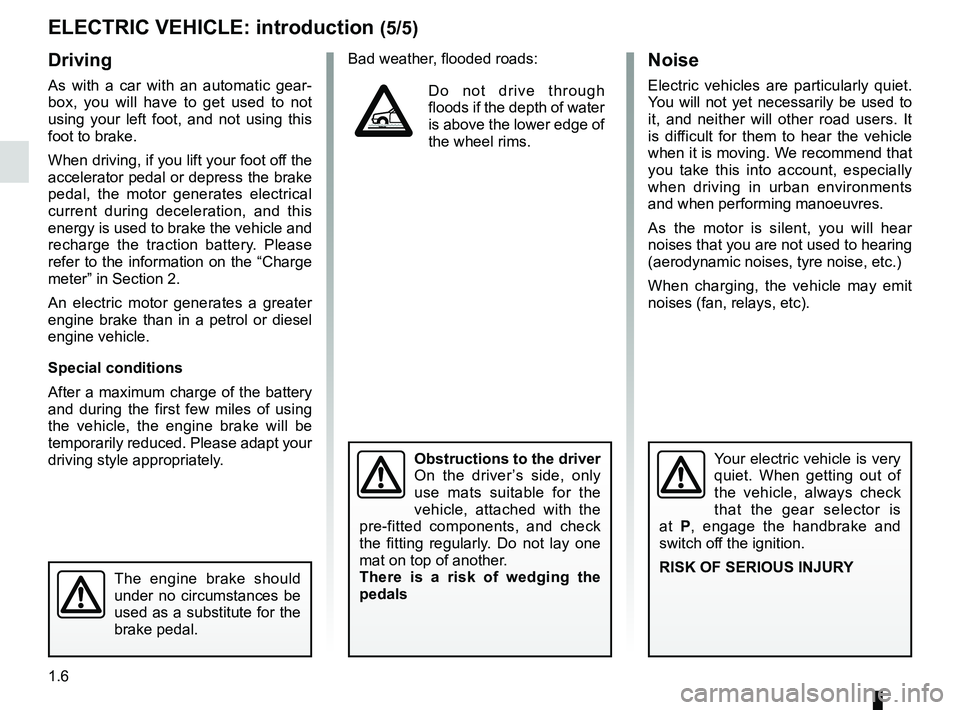
electric vehiclenoise ................................................................ (current page)
electric vehicle driving .............................................................. (current page)
1.6
ENG_UD28730_3
Présentation (X38 - L38 électrique - Renault)
ENG_NU_914-4_L38e_Renault_1
electric vehicle: introduction (5/5)
Noise
Electric vehicles are particularly quiet.
You will not yet necessarily be used to
it, and neither will other road users. It
is difficult for them to hear the vehicle
when it is moving. We recommend that
you take this into account, especially
when driving in urban environments
and when performing manoeuvres.
As the motor is silent, you will hear
noises that you are not used to hearing
(aerodynamic noises, tyre noise, etc.)
When charging, the vehicle may emit
noises (fan, relays, etc).
Your electric vehicle is very
quiet. When getting out of
the vehicle, always check
that the gear selector is
at P, engage the handbrake and
switch off the ignition.
riSK OF SeriOUS iNJUr Y
The engine brake should
under no circumstances be
used as a substitute for the
brake pedal.
Driving
As with a car with an automatic gear -
box, you will have to get used to not
using your left foot, and not using this
foot to brake.
When driving, if you lift your foot off the
accelerator pedal or depress the brake
pedal, the motor generates electrical
current during deceleration, and this
energy is used to brake the vehicle and
recharge the traction battery. Please
refer to the information on the “Charge
meter” in Section 2.
An electric motor generates a greater
engine brake than in a petrol or diesel
engine vehicle.
Special conditions
After a maximum charge of the battery
and during the first few miles of using
the vehicle, the engine brake will be
temporarily reduced. Please adapt your
driving style appropriately. Bad weather, flooded roads:Do not drive through
floods if the depth of water
is above the lower edge of
the wheel rims.
Obstructions to the driver
On the driver ’s side, only
use mats suitable for the
vehicle, attached with the
pre-fitted components, and check
the fitting regularly. Do not lay one
mat on top of another.
t here is a risk of wedging the
pedals
Page 12 of 195
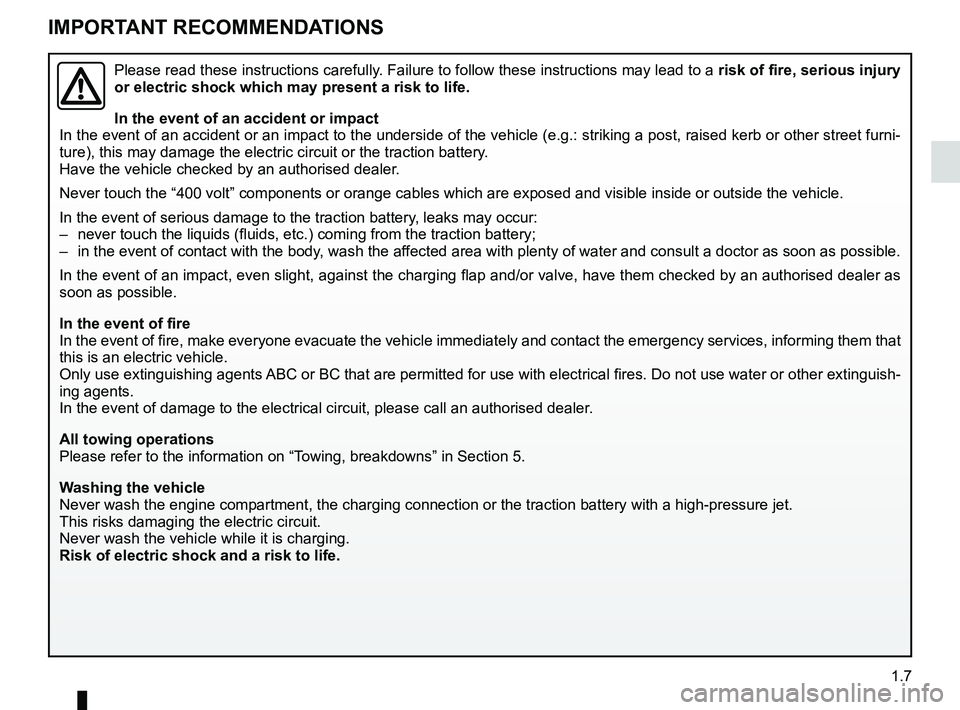
»400 volt» electrical circuit .................................... (current page)
charging flap .......................................................... (current page)
electric vehicle important recommendations ............................ (current page)
traction battery ....................................................... (current page)
1.7
ENG_UD28908_4
Recommandations importantes (X38 - X61 électrique - L38 électriqu\
e - Renault)
ENG_NU_914-4_L38e_Renault_1
Important recommendations
imPOrt ANt recOmmeNDA tiONS
Please read these instructions carefully. Failure to follow these instructions may lead to a risk of fire, serious injury
or electric shock which may present a risk to life.
in the event of an accident or impact
In the event of an accident or an impact to the underside of the vehicle (e.g.: striking a post, raised kerb or other street furni-
ture), this may damage the electric circuit or the traction battery.
Have the vehicle checked by an authorised dealer.
Never touch the “400 volt” components or orange cables which are e\
xposed and visible inside or outside the vehicle.
In the event of serious damage to the traction battery, leaks may occur:
– never touch the liquids (fluids, etc.) coming from the traction battery;
– in the event of contact with the body, wash the affected area with plenty of water and consult a doctor as soon as possibl\
e.
In the event of an impact, even slight, against the charging flap and/or valve, have them checked by an authorised dealer as
soon as possible.
in the event of fire
In the event of fire, make everyone evacuate the vehicle immediately and contact the emergency services, informing them that
this is an electric vehicle.
Only use extinguishing agents ABC or BC that are permitted for use with electrical fires. Do not use water or other extinguish -
ing agents.
In the event of damage to the electrical circuit, please call an authori\
sed dealer.
All towing operations
Please refer to the information on “Towing, breakdowns” in Section 5.
Washing the vehicle
Never wash the engine compartment, the charging connection or the tracti\
on battery with a high-pressure jet.
This risks damaging the electric circuit.
Never wash the vehicle while it is charging.
risk of electric shock and a risk to life.
Page 14 of 195
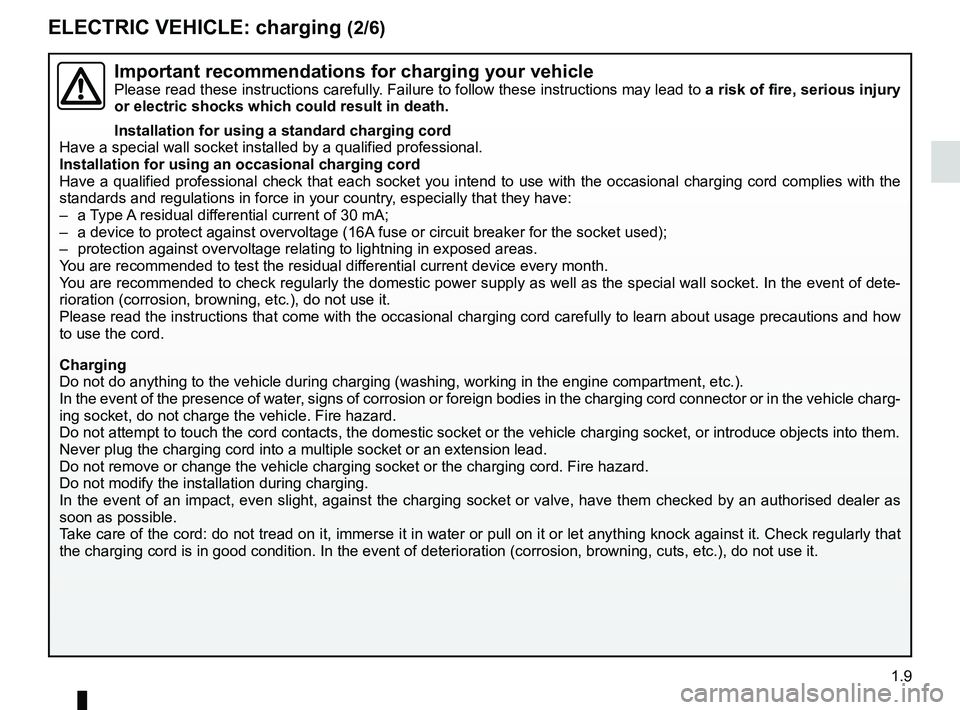
electric vehicleimportant recommendations ............................ (current page)
electrical installation .............................................. (current page)
JauneNoirNoir texte
1.9
ENG_UD28731_4
Charge de la batterie de traction (X38 - L38 électrique - Renault)
ENG_NU_914-4_L38e_Renault_1
electric vehicle: charging (2/6)
important recommendations for charging your vehiclePlease read these instructions carefully. Failure to follow these instructions may lead to a risk of fire, serious injury
or electric shocks which could result in death.
installation for using a standard charging cord
Have a special wall socket installed by a qualified professional.
installation for using an occasional charging cord
Have a qualified professional check that each socket you intend to use with the occasional charging cord complies with the
standards and regulations in force in your country, especially that they have:
– a Type A residual differential current of 30 mA;
– a device to protect against overvoltage (16A fuse or circuit breaker for the socket used);
– protection against overvoltage relating to lightning in exposed areas.
You are recommended to test the residual differential current device every month.
You are recommended to check regularly the domestic power supply as well as the special wall socket. In the event of dete-
rioration (corrosion, browning, etc.), do not use it.
Please read the instructions that come with the occasional charging cord carefully to learn about usage precautions and how
to use the cord.
charging
Do not do anything to the vehicle during charging (washing, working in \
the engine compartment, etc.).
In the event of the presence of water, signs of corrosion or foreign bodies in the charging cord connector or in the vehicle charg-
ing socket, do not charge the vehicle. Fire hazard.
Do not attempt to touch the cord contacts, the domestic socket or the ve\
hicle charging socket, or introduce objects into them.
Never plug the charging cord into a multiple socket or an extension lead\
.
Do not remove or change the vehicle charging socket or the charging cord\
. Fire hazard.
Do not modify the installation during charging.
In the event of an impact, even slight, against the charging socket or valve, have them checked by an authorised dealer as
soon as possible.
Take care of the cord: do not tread on it, immerse it in water or pull on it or let anything knock against it. Check regularly that
the charging cord is in good condition. In the event of deterioration (\
corrosion, browning, cuts, etc.), do not use it.
Page 21 of 195
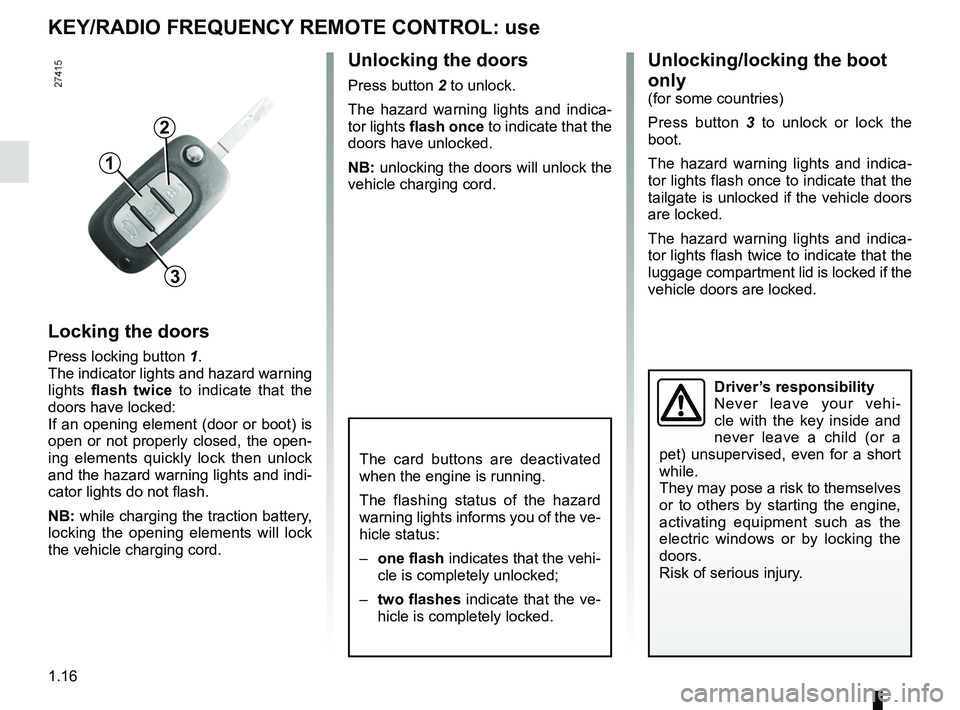
keys ...................................................... (up to the end of the DU)
locking the doors .................................. (up to the end of the DU)
1.16
ENG_UD21528_3
Télécommande à radiofréquence : utilisation (L38 - X38 - Re\
nault)
ENG_NU_914-4_L38e_Renault_1
Unlocking the doors
Press button 2 to unlock.
The hazard warning lights and indica -
tor lights flash once to indicate that the
doors have unlocked.
NB: unlocking the doors will unlock the
vehicle charging cord.
KeY/rADiO FreqUeNcY remOte cONtrOl: use
locking the doors
Press locking button 1.
The indicator lights and hazard warning
lights flash twice to indicate that the
doors have locked:
If an opening element (door or boot) is
open or not properly closed, the open -
ing elements quickly lock then unlock
and the hazard warning lights and indi -
cator lights do not flash.
NB: while charging the traction battery,
locking the opening elements will lock
the vehicle charging cord.
3
1
2
Unlocking/locking the boot
only
(for some countries)
Press button 3 to unlock or lock the
boot.
The hazard warning lights and indica -
tor lights flash once to indicate that the
tailgate is unlocked if the vehicle doors
are locked.
The hazard warning lights and indica -
tor lights flash twice to indicate that the
luggage compartment lid is locked if the
vehicle doors are locked.
Driver’s responsibility
Never leave your vehi -
cle with the key inside and
never leave a child (or a
pet) unsupervised, even for a short
while.
They may pose a risk to themselves
or to others by starting the engine,
activating equipment such as the
electric windows or by locking the
doors.
Risk of serious injury.
The card buttons are deactivated
when the engine is running.
The flashing status of the hazard
warning lights informs you of the ve-
hicle status:
– one flash indicates that the vehi-
cle is completely unlocked;
– two flashes indicate that the ve-
hicle is completely locked.
Page 22 of 195
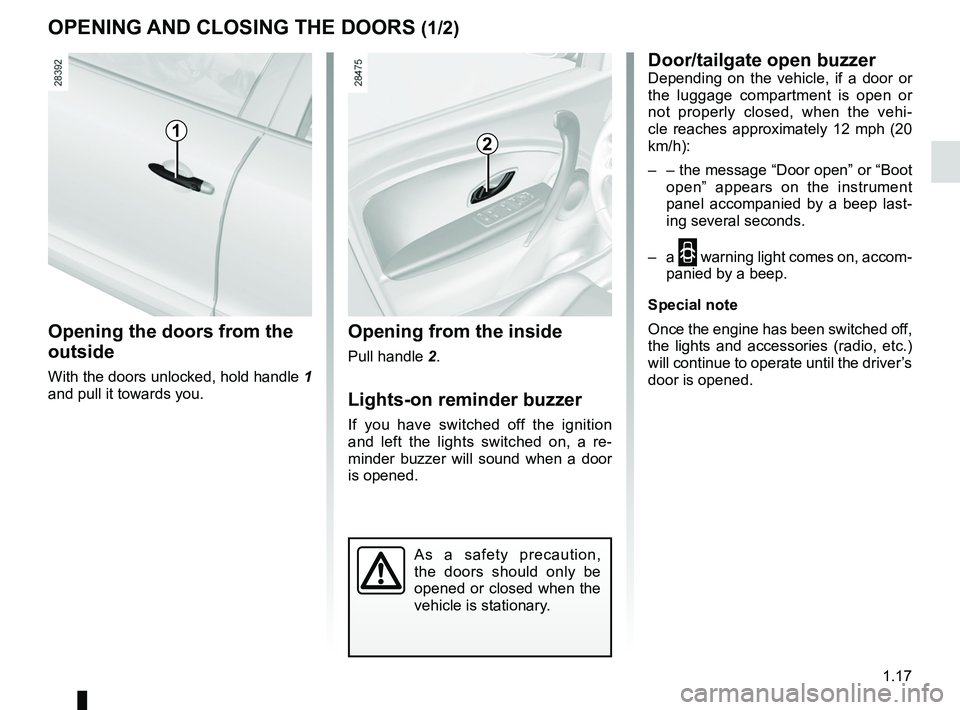
warning buzzer ...................................................... (current page)
doors ..................................................... (up to the end of the DU)
locking the doors .................................. (up to the end of the DU)
opening the doors ................................. (up to the end of the DU)
closing the doors .................................. (up to the end of the DU)
children ................................................. (up to the end of the DU)
doors/tailgate ........................................ (up to the end of the DU)
1.17
ENG_UD20061_2
Ouverture et fermeture des portes (L38 - X38 - Renault)
ENG_NU_914-4_L38e_Renault_1
Doors
OPeNiNg AND clOSiNg the DOOrS (1/2)
Opening the doors from the
outside
With the doors unlocked, hold handle 1
and pull it towards you.
Opening from the inside
Pull handle 2.
lights-on reminder buzzer
If you have switched off the ignition
and left the lights switched on, a re -
minder buzzer will sound when a door
is opened.
Door/tailgate open buzzerDepending on the vehicle, if a door or
the luggage compartment is open or
not properly closed, when the vehi -
cle reaches approximately 12 mph (20
km/h):
– – the message “Door open ” or “Boot
open ” appears on the instrument
panel accompanied by a beep last -
ing several seconds.
– a
2 warning light comes on, accom-
panied by a beep.
Special note
Once the engine has been switched off,
the lights and accessories (radio, etc.)
will continue to operate until the driver’s
door is opened.
12
As a safety precaution,
the doors should only be
opened or closed when the
vehicle is stationary.
Page 23 of 195
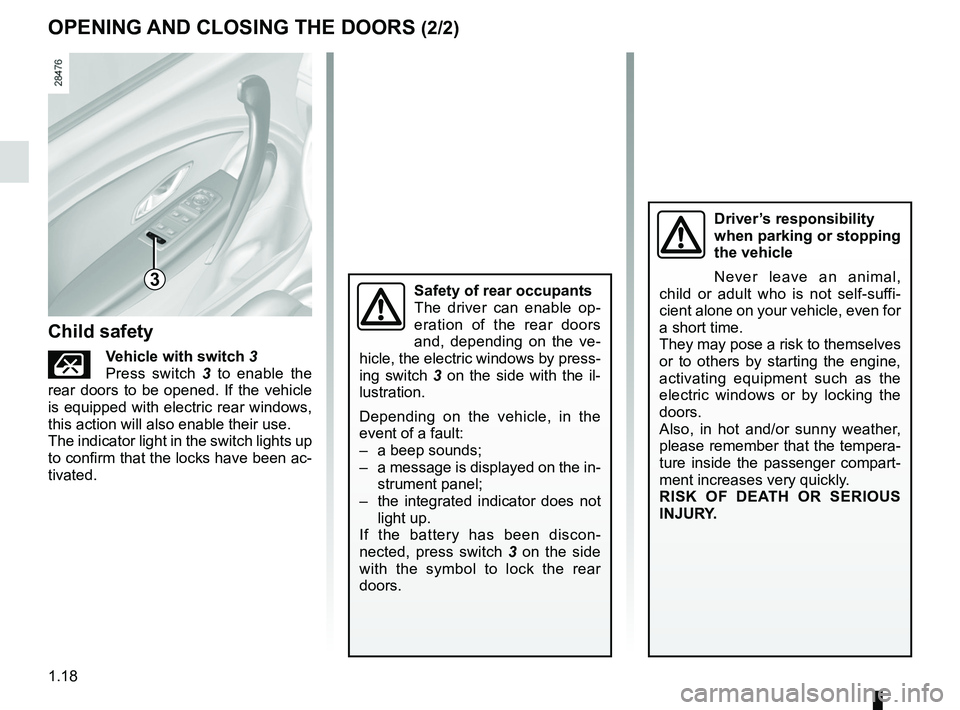
1.18
ENG_UD20061_2
Ouverture et fermeture des portes (L38 - X38 - Renault)
ENG_NU_914-4_L38e_Renault_1
OPeNiNg AND clOSiNg the DOOrS (2/2)
Driver’s responsibility
when parking or stopping
the vehicle
Never leave an animal,
child or adult who is not self-suffi -
cient alone on your vehicle, even for
a short time.
They may pose a risk to themselves
or to others by starting the engine,
activating equipment such as the
electric windows or by locking the
doors.
Also, in hot and/or sunny weather,
please remember that the tempera-
ture inside the passenger compart-
ment increases very quickly.
ri SK OF D eAth Or S eri OUS
iNJUr Y.
child safety
Çvehicle with switch 3
Press switch 3 to enable the
rear doors to be opened. If the vehicle
is equipped with electric rear windows,
this action will also enable their use.
The indicator light in the switch lights up
to confirm that the locks have been ac-
tivated.
Safety of rear occupants
The driver can enable op -
eration of the rear doors
and, depending on the ve -
hicle, the electric windows by press-
ing switch 3 on the side with the il-
lustration.
Depending on the vehicle, in the
event of a fault:
– a beep sounds;
– a message is displayed on the in-
strument panel;
– the integrated indicator does not
light up.
If the battery has been discon -
nected, press switch 3 on the side
with the symbol to lock the rear
doors.3
Page 25 of 195
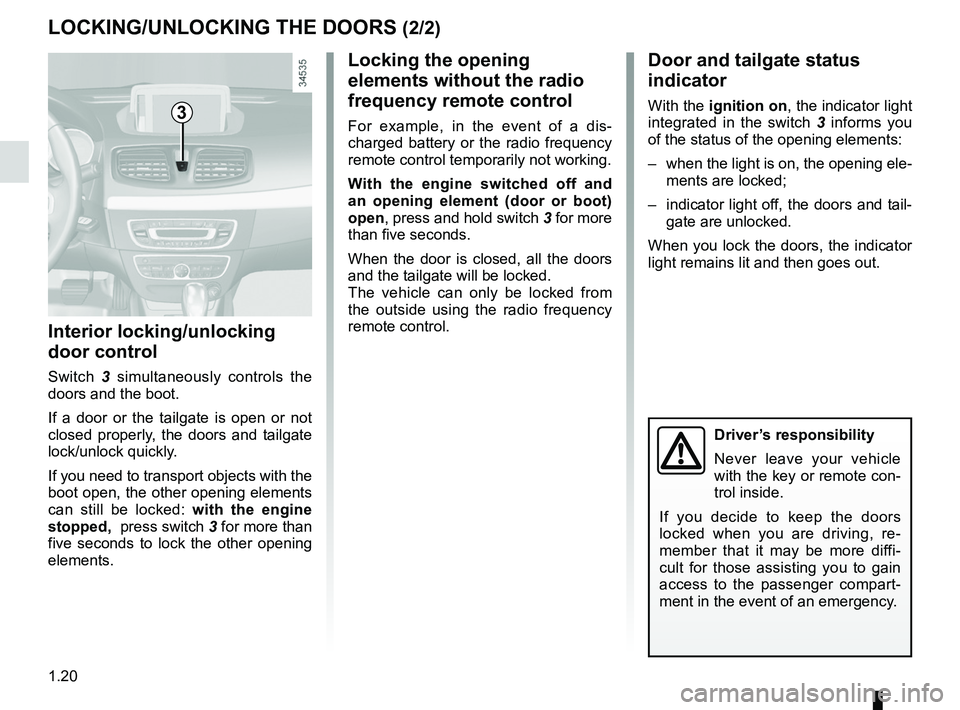
1.20
ENG_UD20063_2
Verrouillage / Déverrouillage des portes (L38 - X38 - Renault)
ENG_NU_914-4_L38e_Renault_1
lOcKiNg/UNlOcKiNg the DOOrS (2/2)
interior locking/unlocking
door control
Switch 3 simultaneously controls the
doors and the boot.
If a door or the tailgate is open or not
closed properly, the doors and tailgate
lock/unlock quickly.
If you need to transport objects with the
boot open, the other opening elements
can still be locked: with the engine
stopped, press switch 3 for more than
five seconds to lock the other opening
elements.
locking the opening
elements without the radio
frequency remote control
For example, in the event of a dis -
charged battery or the radio frequency
remote control temporarily not working.
With the engine switched off and
an opening element (door or boot)
open, press and hold switch 3 for more
than five seconds.
When the door is closed, all the doors
and the tailgate will be locked.
The vehicle can only be locked from
the outside using the radio frequency
remote control.
Door and tailgate status
indicator
With the ignition on, the indicator light
integrated in the switch 3 informs you
of the status of the opening elements:
– when the light is on, the opening ele-
ments are locked;
– indicator light off, the doors and tail-
gate are unlocked.
When you lock the doors, the indicator
light remains lit and then goes out.3
Driver’s responsibility
Never leave your vehicle
with the key or remote con-
trol inside.
If you decide to keep the doors
locked when you are driving, re -
member that it may be more diffi -
cult for those assisting you to gain
access to the passenger compart -
ment in the event of an emergency.
Page 26 of 195
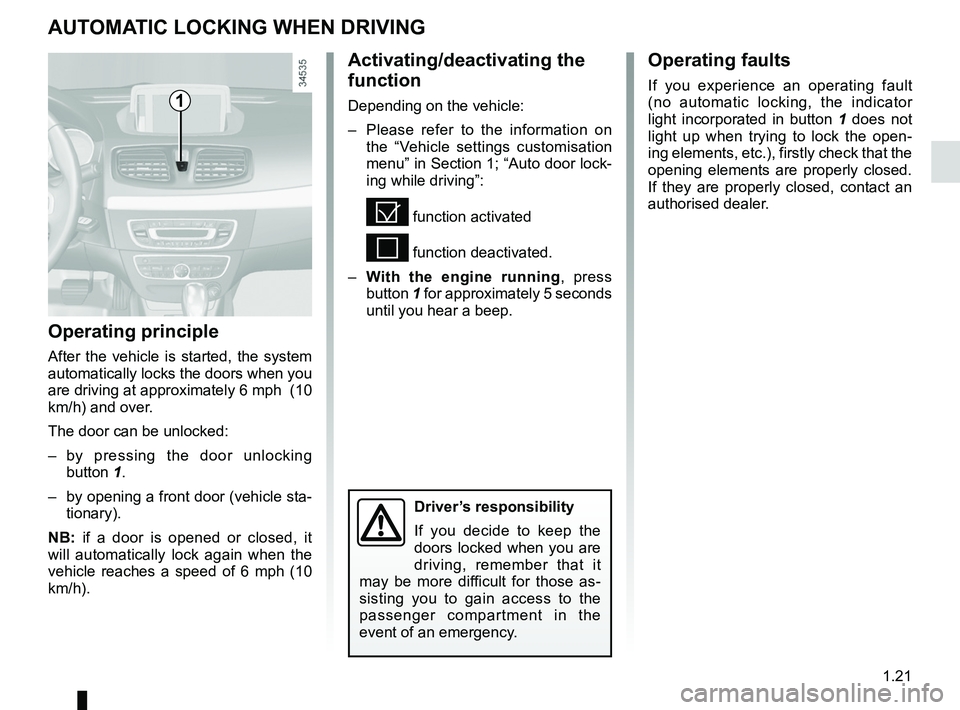
RENAULT ANTI-INTRUDER DEVICE (RAID) (up to the end of the DU)
central door locking .............................. (up to the end of the DU)
doors ..................................................... (up to the end of the DU)
locking the doors .................................. (up to the end of the DU)
doors/tailgate ........................................ (up to the end of the DU)
1.21
ENG_UD21529_3
Condamnation automatique des ouvrants en roulage (L38 - X38 - Renault)\
ENG_NU_914-4_L38e_Renault_1
Automatic locking of opening elements when driving
AUt OmA tic lOcKiNg WheN DriviNg
Activating/deactivating the
function
Depending on the vehicle:
– Please refer to the information on
the “Vehicle settings customisation
menu” in Section 1; “Auto door lock-
ing while driving ”:
= function activated
< function deactivated.
– With the engine running , press
button 1 for approximately 5 seconds
until you hear a beep.
Operating principle
After the vehicle is started, the system
automatically locks the doors when you
are driving at approximately 6 mph (10
km/h) and over.
The door can be unlocked:
– by pressing the door unlocking
button 1.
– by opening a front door (vehicle sta-
tionary).
NB: if a door is opened or closed, it
will automatically lock again when the
vehicle reaches a speed of 6 mph (10
km/h).
Operating faults
If you experience an operating fault
(no automatic locking, the indicator
light incorporated in button 1 does not
light up when trying to lock the open -
ing elements, etc.), firstly check that the
opening elements are properly closed.
If they are properly closed, contact an
authorised dealer.1
Driver’s responsibility
If you decide to keep the
doors locked when you are
driving, remember that it
may be more difficult for those as -
sisting you to gain access to the
passenger compartment in the
event of an emergency.
Page 32 of 195

JauneNoirNoir texte
1.27
ENG_UD25350_3
Ceintures de sécurité (L38 - X38 - Renault)
ENG_NU_914-4_L38e_Renault_1
UnfasteningPress button 4 and the seat belt will be
rewound by the inertia reel. Guide the
belt into position.
™Front seat belt reminder
warning light
It lights up on the central display when
the engine is started and, if the driv -
er’s seat belt is not fastened, the light
flashes and a beep sounds for about
two minutes when the vehicle reaches
a speed of approximately 12 mph
(20 km/h).
NB: an object placed on the passenger
seat cushion may activate the warning
light in some cases.
SeA t BeltS (2/3)
locking
Unwind the belt slowly and smoothly
and ensure that buckle 3 locks into
catch 5 (check that it is locked by pull -
ing on buckle 3). If the belt jams, allow
it to return slightly before attempting to
unwind it again.
If your seat belt is completely jammed,
pull slowly, but firmly, so that just over
3 cm unwinds. Allow it to return slightly
before attempting to unwind it again.
If there is still a problem, contact an ap-
proved dealer.
1
5
34
5
Adjusting the front seat belt
height
Press button 6 to adjust the seat belt
height so that the shoulder strap 1 is
worn as shown previously:
– to lower the seat belt, press button 6
and lower the seat belt at the same
time;
– to raise the seat belt, press button 6
and raise the seat belt at the same
time.
Make sure that the seat belt is locked
in position correctly after you have ad-
justed it.
6
Page 40 of 195
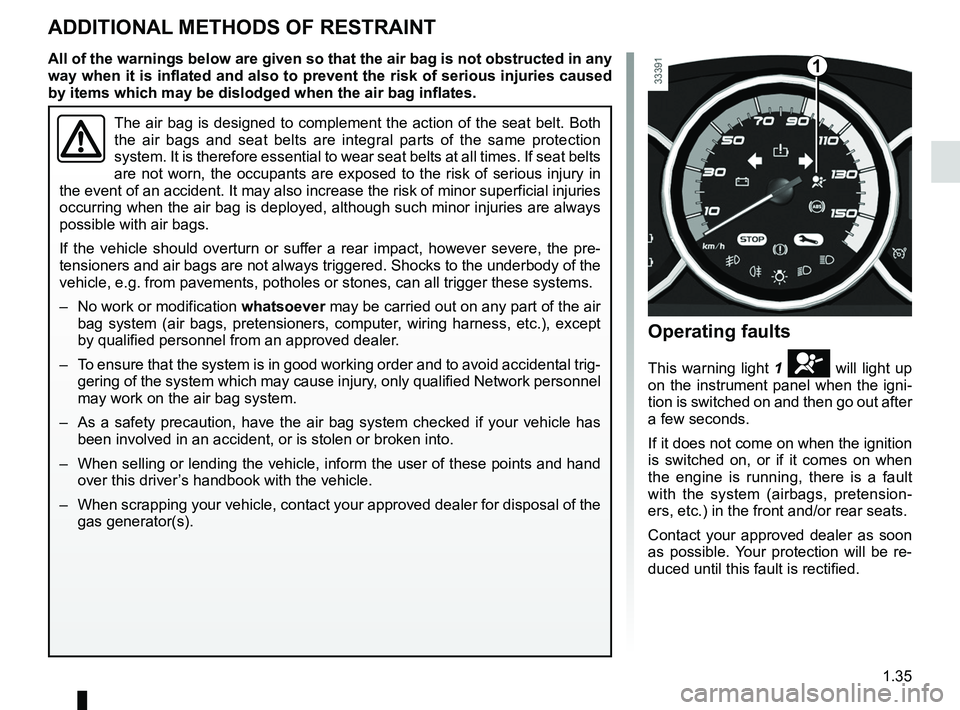
air bag................................................... (up to the end of the DU)
methods of restraint in addition to the seat belts
(up to the end of the DU)
additional methods of restraint ............. (up to the end of the DU)
seat belts .............................................. (up to the end of the DU)
air bag ................................................... (up to the end of the DU)
1.35
ENG_UD23682_2
Dispositifs de retenue complémentaire (L38 - X38 - Renault)
ENG_NU_914-4_L38e_Renault_1
ADDitiONAl methODS OF reStrAiNt
The air bag is designed to complement the action of the seat belt. Both
the air bags and seat belts are integral parts of the same protection
system. It is therefore essential to wear seat belts at all times. If seat belts
are not worn, the occupants are exposed to the risk of serious injury in
the event of an accident. It may also increase the risk of minor superficial injuries
occurring when the air bag is deployed, although such minor injuries are always
possible with air bags.
If the vehicle should overturn or suffer a rear impact, however severe, the pre-
tensioners and air bags are not always triggered. Shocks to the underbody of the
vehicle, e.g. from pavements, potholes or stones, can all trigger these \
systems.
– No work or modification whatsoever may be carried out on any part of the air
bag system (air bags, pretensioners, computer, wiring harness, etc.), except
by qualified personnel from an approved dealer.
– To ensure that the system is in good working order and to avoid accidental trig-
gering of the system which may cause injury, only qualified Network personnel
may work on the air bag system.
– As a safety precaution, have the air bag system checked if your vehicle has
been involved in an accident, or is stolen or broken into.
– When selling or lending the vehicle, inform the user of these points and hand
over this driver’s handbook with the vehicle.
– When scrapping your vehicle, contact your approved dealer for disposal of the
gas generator(s).
Operating faults
This warning light 1 å will light up
on the instrument panel when the igni -
tion is switched on and then go out after
a few seconds.
If it does not come on when the ignition
is switched on, or if it comes on when
the engine is running, there is a fault
with the system (airbags, pretension -
ers, etc.) in the front and/or rear seats.
Contact your approved dealer as soon
as possible. Your protection will be re-
duced until this fault is rectified.
1All of the warnings below are given so that the air bag is not obstructed in any
way when it is inflated and also to prevent the risk of serious injuries caused
by items which may be dislodged when the air bag inflates.